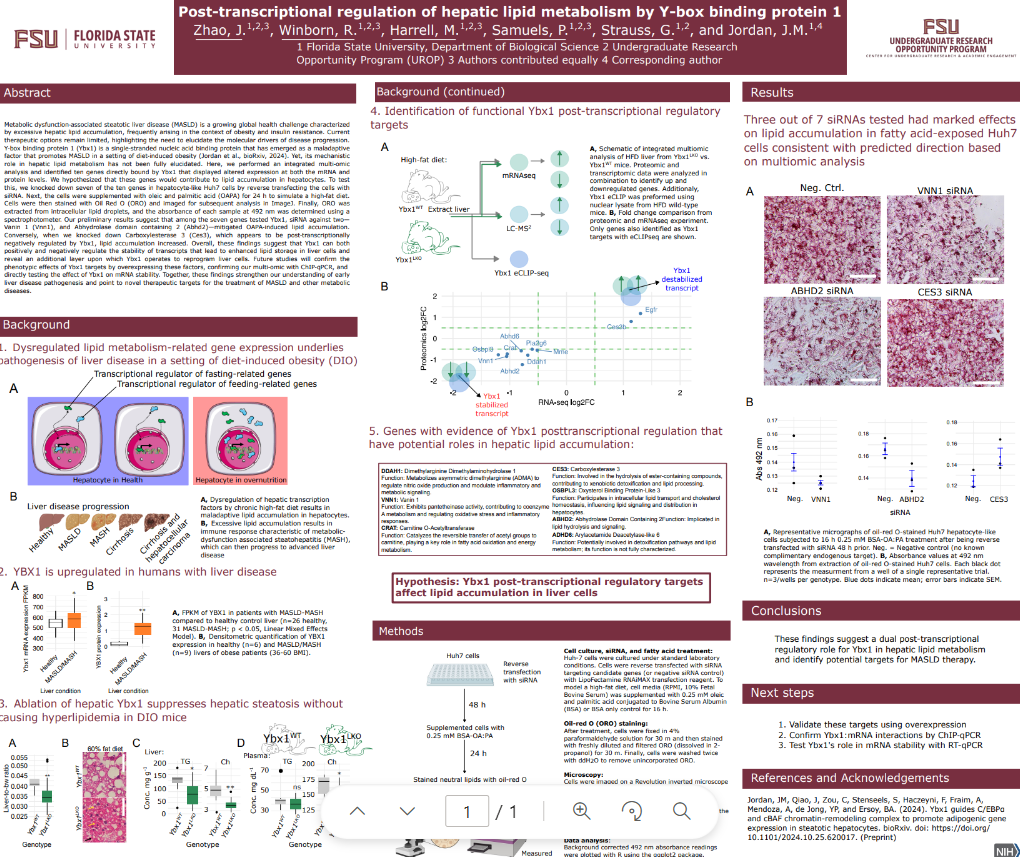Research Symposium
25th annual Undergraduate Research Symposium, April 1, 2025
Rebekah Winborn Poster Session 3: 1:45 pm - 2:45 pm / Poster #217
BIO
Rebekah is a second year undergraduate student majoring in Biological Sciences from Fort Myers, Florida. She has an interest in gastroenterology, dentistry, and pathology. She is involved with the Pride Student Union as their Membership Coordinator, and Hillel at FSU, along with her research in Dr. Jordan's research laboratory.
Post-transcriptional regulation of hepatic lipid metabolism by Y-box binding protein 1
Authors: Rebekah Winborn, James JordanStudent Major: Biological Sciences
Mentor: James Jordan
Mentor's Department: Department of Biology Mentor's College: College of Arts and Sciences Co-Presenters: Jack Zhao, Paulos Samuel, Mia Harrell
Abstract
Metabolic dysfunction‐associated steatotic liver disease (MASLD) is a growing global health challenge characterized by excessive hepatic lipid accumulation in the setting of obesity and insulin resistance. Current therapies remain limited, underscoring the need to identify molecular drivers of disease progression. Y‐box binding protein-1 (Ybx1) is a single‐stranded nucleic acid binding protein implicated in MASLD in diet‐induced obesity (Jordan et al., bioRxiv, 2024), yet its role in hepatic lipid metabolism remains unclear. We performed an integrated multi‐omic analysis and identified ten genes bound by Ybx1 that displayed altered mRNA and protein expression. We hypothesized that these genes contribute to lipid accumulation in hepatocytes. To test this, we knocked down eight of these genes in hepatocyte‐like Huh7 cells using siRNA. Cells were then exposed to 0.25 mM oleic and palmitic acid for 16 hours to mimic a high‐fat diet, stained with Oil Red O, and analyzed using ImageJ. Lipid content was quantified by extracting Oil Red O from intracellular droplets and measuring absorbance at 492 nm. Preliminary results indicate that among seven genes with transcripts stabilized by Ybx1, siRNA against three—Carnitine O-Acetyltransferase (CRAT), Vanin 1 (Vnn1), and Abhydrolase domain containing 2 (Abhd2)—reduced lipid accumulation. In contrast, knockdown of Carboxylesterase 3 (Ces3), a gene negatively regulated by Ybx1, increased lipid storage. These findings reveal a dual regulatory role for Ybx1 in hepatic lipid metabolism and identify potential targets for MASLD therapy. Future work will validate these targets using overexpression, confirm Ybx1:mRNA interactions by ChIP‐qPCR, and test Ybx1’s role in mRNA stability with RT-qPCR.
Keywords: biology, liver, obesity, genetics, RNA


